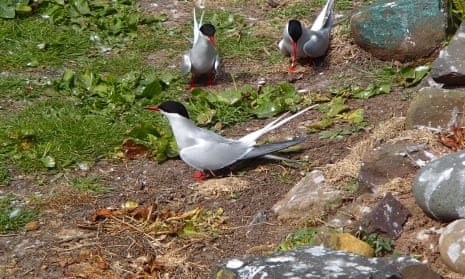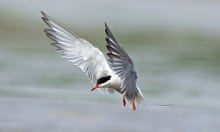A tiny bird from the Farne Islands off Northumberland has clocked up the longest migration ever recorded. The Arctic tern’s meandering journey to Antarctica and back saw it clock up 59,650 miles, more than twice the circumference of the planet.
The bird, which weighs just 100g, left its breeding grounds last July and flew down the west coast of Africa, rounded the Cape of Good Hope into the Indian Ocean and arrived in Antarctica in November. Its mammoth trek was recorded by a tiny device attached to its leg, weighing 0.7g - too light to affect its flight.
“It’s really quite humbling to see these tiny birds return when you consider the huge distances they’ve had to travel and how they’ve battled to survive,” said Richard Bevan at Newcastle University and part of the tracking team.
The birds survive the vast journey by dipping down to the sea surface to catch fish and other food as they travel. “They live in the fast lane all the time, constantly on the move,” said Bevan. “They have to flap all the time. It is an incredibly energetic lifestyle.”
Like all migratory animals, the birds travel to take advantage of food that is available in particular seasons. Arctic terns perform the longest migrations but another bird, the bar-tailed godwit, completes its marathon from the Arctic to New Zealand in eight days straight, without stopping to feed. Whales undertake the longest mammal migrations and leatherback turtles and some dragonflies also travel over 9,321 miles.
More than 2,000 pairs of Arctic terns breed on the Farne Islands, where they feed on sand eels in the sea. The terns are not globally threatened but are thought to be declining in number.
Colonies in the Shetlands and Outer Hebrides have been producing far fewer chicks than normal, possibly because the sand eels are moving northwards as climate change warms the oceans. “Terns are incredibly sensitive to changes in the marine environment,” said Bevan. “They are the classic canary of the seas.”
Scientists attached tags to 29 birds and 20 are known to have returned. Some may have died or it may be that the terns do not return every year to the UK to breed. “Further analysis of the data from these trackers will allow us to get a better understanding of how the Arctic terns organise their migration and how global climate change may affect their routes,” said Bevan.
Arctic terns can live for 15 to 30 years, meaning the the record-breaking tern could fly as far as 3m kilometres over its lifetime, the rough equivalent of four round trips to the moon. “We are just scratching the surface about this birds and its capabilities,” said Bevan.
The study was partly funded by the BBC programme Springwatch, which will feature the Arctic tern migration on Tuesday 7 June.




Comments (…)
Sign in or create your Guardian account to join the discussion